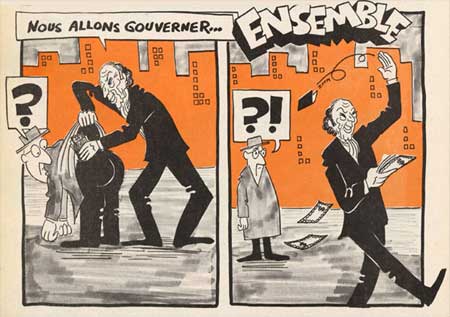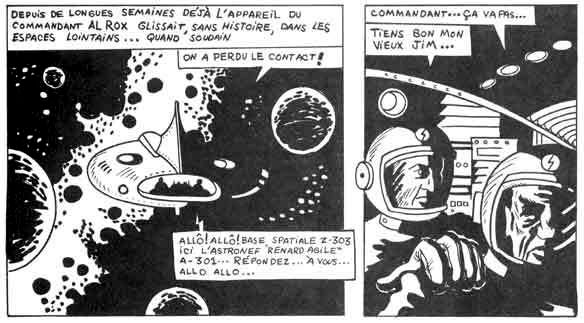From: 'La Drapolice', featuring Jean Drapeau, mayor of Montréal, as a pirate.
Pierre Dupras is a Canadian political cartoonist, comic artist, painter and sculptor. He was part of the counterculture movement of the 1960s and 1970s and best known for his 1969-1974 political comic strips in Québec-Presse. His satire has often been controversial and during the 1970 political crisis in his country, he was nearly arrested for his work. Apart from political comics Dupras also holds importance for creating one of the earliest Canadian autobiographical comics.
Early life and career
Pierre Dupras was born in 1937 in Montréal. He studied art at the local Grasset college, where he already published caricatures and cartoons in the school paper. He regards magazines like Hara-Kiri (Charlie-Hebdo), Pilote and artists like Honoré Daumier, Hergé, Normand Hudon, Siné, Jean-Marc Reiser and Gotlib as his main graphic influences. His earliest humorous drawings appeared in the Catholic magazine François at the end of the 1950s. Between 1964 and 1967, Dupras alternated with and eventually succeeded Jean-Pierre Girerd as the house cartoonist of Le Dimanche-Matin, where he illustrated the daily chronicle of Janette Bertrand. Girerd eventually moved to another paper, La Presse. Between 5 October 1965 and 4 April 1967, Dupras contributed to Le Quartier-Latin, the magazine of the University of Montréal.
Cartoon by Pierre Dupras. From 'Vive Le Québec Libre!'.
Charles de Gaulle controversy
In 1967, French president Charles de Gaulle visited Québec. As the president gave a speech in Montréal on 24 July, he closed his statement with the slogan: "Vive le Québec libre!" ("Long live free Quebec!"). The independence of the Canadian province Québec has always been a controversial issue and led to a diplomatic crisis between Canada and France. It inspired various cartoonists, among them Dupras, to publish the book 'Vive le Québec Libre!' (Éditions de l'Homme, 1967), which collected 125 caricatures about the visit. This effectively cost him his job at Dimanche-Matin, since they wanted him to remain neutral, which he refused.
Political work
Between November 1967 and June 1968, Dupras became even more politically outspoken when he joined L'Indépendance, the official magazine of the Rassemblement Pour L'Indépendance Nationale, who favored Québec's independence. For this magazine, he created his first comic strips, which already dealt with the politics of the day. Journalist Jacques Elliot recognized his talent and invited him to participate with the left-wing Sunday magazine Québec-Presse. Dupras always felt that comics are far more interesting than just a caricature in a one-panel cartoon. To him, the genre catches the readers' attention and has the advantage of being able to tell a story. They also allow more opportunity to let different characters discuss different ideas.
'Libres?' (Québec-Presse, 20 May 1973). The politician in the fifth and sixth panel is Jérôme Choquette, while the final panel shows a caricature of Robert Bourassa.
Il Faut Être Fier d'Être Canadien!
On 31 May 1970, Dupras started a political-satirical comic strip in Québec-Presse, originally titled 'Il Faut Être Fier d'Être Canadien!' ('One Should Be Proud Of Being Canadian', 1969-1974). The title was meant to be ironic, as the comic strip tackled many controversial issues about the country, directly portraying Prime Minister Pierre Trudeau, politicians Robert Bourassa, René Lévesque and especially Jean Drapeau, the mayor of Montréal. Even the Commonwealth was not spared, as a portrait of Queen Elizabeth II is always seen in a framed picture. Naturally the government's attitude towards Québec was a recurring topic.
Dupras' comic strip gained infamy during the 1970 October Crisis. During that month, the terrorist group Front de Libération du Québec kidnapped Canadian politician Pierre Laporte and British diplomat James Cross, whereupon Canadian Prime Minister Pierre Trudeau decided to invoke the War Measures Act. This controversial decision led to the arrest of hundreds of people without bail, but was supported by certain politicians, among them Jean Drapeau. In this politically heated climate, where the government couldn't prevent Laporte's murder but did liberate Cross, Dupras' political satire was met with hostility. He nearly got arrested, but famous cartoonist Robert LaPalme intervened. LaPalme was a friend of Drapeau and stated that "a cartoonist is a country's conscience". This saved Dupras from an arrest, while his colleagues at the Québec-Presse weren't so lucky. Though in the end, all of them were released again without any charges.
'La Drapolice', satirizing Jean Drapeau, mayor of Montréal.
Cartoon books
Those who thought (or hoped) that Dupras would tone down his cartoons after his arrest in 1970 on were sadly mistaken. He kept creating politically heated comics, several of which were collected in book format by Les Éditions Québec-Presse. His book 'La Drapolice' (1971) attacked Drapeau's authoritarian politics and compared him with Hitler. 'Recettes Pour Chômeurs et Grévistes' (1971) lampooned a strike at the journal La Presse, while 'La Bataille des Chefs' (1973) dealt with the federal elections. His final book published by them was 'Oui ou Non' (1980), about a referendum on the issue Québec. It was made in collaboration with his son Martin, A.K.A. "L'Oncle Gratt". Other Canadians who made political comic strips around the same time period were Jean-Paul Landry, with 'Chers Zélecteurs' (1972), and Robert Toupin, with 'Élection à Québec' (1973). A recurring character in many of Dupras' comics is a little tortoise. This alter ego made its debut on 13 May 1973.
'La Bataille des Chefs' (1973), featuring a cameo of Canadian Prime Minister Pierre Trudeau.
Later cartooning work
Throughout the 1970s, Dupras remained active in comics. He participated with the magazine BD in 1973, contributing several gags and science fiction stories. The artist was one of several cartoonists to contribute to the collective album 'BDK: Bande Dessinée Kébécoise' (1975), which made him a pioneer in Canadian autobiographical comics. Dupras also created 125 comics used in the educational TV series 'Les Oraliens' (1969-1980), produced by Télé-Québec. The show revolved around an Earth inhabitant and two extraterrestrial beings from the planet Oralie. This was used as a leeway to teach children about certain topics like biology, geography, art and history. Dupras created thematic illustrations for each broadcast.
'Ael-Fal' (BD Vol. 2 #1).
Other activities
When the Québec-Presse closed down, Dupras became an art teacher. In 1987, he drew the educational comic 'La Bataille de Saint-Eustache'. He illustrated 'Dictionnaire Saugrenu' (2015) by Normand Cazelais, which combines verbal wordplay and humorous cartoons. Dupras obtained a certificate in film (1983-1984), art (1984-1985) and sculpture (1987) from the University of Québec in Montréal. He spent the past decades making abstract geometric paintings and sculptures. His private garden contains many of his large abstract sculptures in welded iron and his figurative works inspired by Greco-Roman mythology. His work has often been exhibited, both in group and in solo expositions.
From: 'Oui où non?'. The man asks Ernest whether he believes in people's right to gain independence, that all finances should be their rights and property and that the ought to be the only ones to make our laws, to which he all replies: "Yes." But when he makes him the "logical conclusion" that Ernest must be in favor of (Québec's) independence then, his conversation partner firmly denies it.









